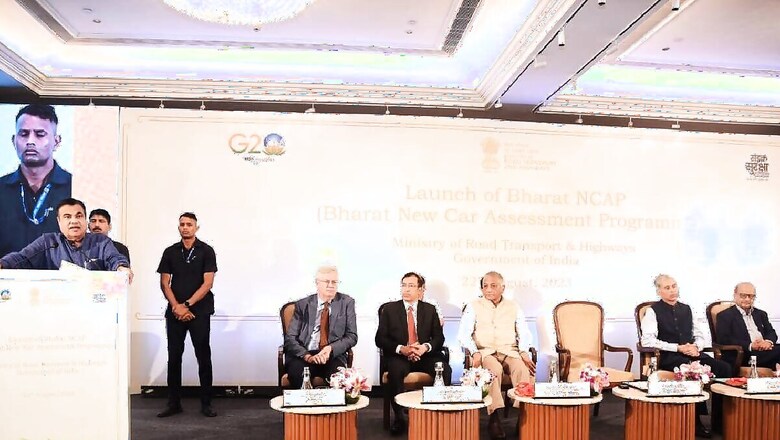
views
India has achieved a significant milestone in road safety today by launching its own crash test rating structure. It becomes the fifth country worldwide to achieve this milestone.
The Ministry of Road Transport and Highways (MORTH) and Global NCAP jointly announced the highly anticipated Bharat NCAP crash test ratings, which comes with a resounding declaration of India’s intention to improve automotive safety. The objective of India’s domestic vehicle safety rating system, which will take effect on October 1, 2023, is to raise national vehicle safety standards.
Honorable Union Minister of Road Transport and Highways, Nitin Gadkari, formally declared the approval of the official notification for BNCAP. This significant announcement confirms India’s commitment to elevating road safety measures.
Driving Towards Safety: BHARAT NCAP Revolutionizes Vehicle Standards in India.#BharatNCAP pic.twitter.com/Y2zA9E3Hni— Nitin Gadkari (@nitin_gadkari) August 22, 2023
At the announcement event, Minister Nitin Gadkari proudly disclosed that the Bharat NCAP program had already garnered over 30 testing requests from various vehicle models. He expressed his gratification towards the automotive sector for embracing the Bharat NCAP initiative. The minister further emphasized that, aside from vehicle safety, the ministry is also addressing the vital aspect of road engineering.
Bharat NCAP: Paving the Way for Safer Roads
The Indian government has meticulously aligned the testing protocols of Bharat NCAP with international crash test standards. This alignment enables the programme to rate the evaluated vehicles on a scale of 1 to 5, with a lower rating signifying lower safety performance. These star ratings will differ for adult occupants (AOP) and child occupants (COP), reflecting how well the vehicle performs in terms of safety for each group.
The comprehensive parameters for star ratings encompass factors such as pedestrian-friendly design, structural integrity, provision of active and passive safety technologies, as well as safety provisions for both adult and child occupants.
Though the evaluation of ‘Safety Assist Technologies’ is a key facet, it is noteworthy that currently, seat belt reminders are mandated only for the front row. Some experts argue that extending this mandate to the rear row could offer a simple and cost-effective enhancement to vehicle safety.
Bharat NCAP: Vehicle Eligibility
The Bharat NCAP crash test program adheres to the Automotive Industry Standard (AIS) 197. The M1 category includes vehicles that can transport up to eight passengers in addition to the driver, weigh less than 3.5 tonnes, and are either locally manufactured or imported into India. The program’s scope includes CNG and electric vehicles in addition to conventional combustion-engine vehicles, broadening the scope of the safety evaluation.
Bharat NCAP: Evaluation Process
The procedure for evaluating vehicles under Bharat NCAP involves several sequential steps:
- Vehicle Model Nomination: Car manufacturers nominate a specific vehicle model.
- Selection and Dispatch: The BNCAP team selects a base variant via random sampling and the manufacturer dispatches it to the testing center.
- Crash Testing: The selected vehicle undergoes crash testing, witnessed by both car manufacturer representatives and the BNCAP team.
- Results Compilation and Approval: Test results are compiled and shared with the manufacturer, followed by approval from the BNCAP standing committee.
- Publication and Certification: Upon standing committee endorsement, the vehicle’s star ratings and crash test results are published by BNCAP, with certification issued by the Central Institute of Road Transport (CIRT).
The evaluation process under Bharat NCAP scrutinizes adult and child occupant protection along with the incorporation of safety assist technologies. Crash tests include the Frontal Impact Test (Offset Deformable Barrier), Side Impact Test, and the Pole Side Impact Test (relevant for 3-4-5 star rated vehicles). The testing speed of 64 kph aligns with international protocols, ensuring comprehensive safety assessments.
In addition to the crash test parameters, safety assist technology criteria are pivotal for determining each rating. These criteria encompass specific safety technologies such as Electronic Stability Program (ESP), pedestrian protection measures for all vehicles, and seat belt reminders for the front row (3-4-5 star ratings).
With the introduction of Bharat NCAP, India has reaffirmed its dedication to promoting safer roads and strengthened its position as a global leader in road safety.














Comments
0 comment